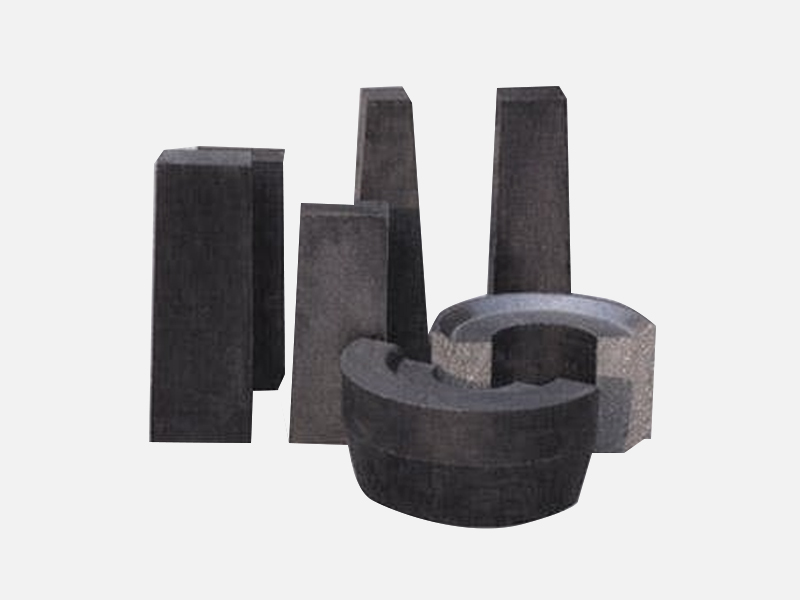Main properties and uses of magnesia carbon brick
Posted time:2022-03-24 Page view:30406Electric furnace magnesium-carbon brick steelmaking, is the use of graphite electrode arc generated between the heat source for steelmaking equipment, divided into DC electric furnace and AC electric furnace, of which AC electric furnace accounted for the majority. According to the damage mechanism of electric furnace, magnesia carbon brick suitable for electric furnace was developed and produced.
Therefore, the graphite content in the brick should be controlled at about 20%. Magnesia carbon brick has little wettability to slag, excellent spalling resistance and erosion resistance, and is suitable for slag line parts of ladle, especially for multi-furnace continuous pouring. In order to meet the need of producing clean steel, the application part of magnesia-carbon brick has been expanded from the slag line to the side wall during the refining of ladle.
When laying magnesia-carbon bricks on ladle, care should be taken not to mix with bricks containing high Si02. Otherwise, the local melting loss of magnesia carbon brick will be increased, and its melting loss mechanism is mainly used in the lining and outlet of the steelmaking oxidation conversion furnace, the hot spot of the furnace wall of the high-power electric furnace, and the lining of the refining furnace outside the furnace and the slag line of the steel drum.
In the smelting process, the use conditions and damage conditions of each part of the converter are different. In order to achieve balanced corrosion loss, for different parts of the converter under different conditions of use, the grade and quality of the selected magnesia carbon brick are also different:
The temperature change of the furnace mouth and the furnace cap is severe, and the slag corrosion is serious. Magnesia carbon brick with good thermal shock resistance and slag resistance should be selected.
In addition to the damage caused by blowing on both sides of the ear shaft, there is no protective slag layer on the surface, which is not easy to repair, and the carbon in the brick is easy to oxidize. High-quality magnesia carbon brick with excellent slag resistance and oxidation resistance should be laid.
The slag line is in contact with the slag for a long time, and the slag corrosion is serious, so it is necessary to lay magnesia-carbon bricks with excellent slag resistance.
When oxygen is blown on the charging side, the splashing action of slag and molten steel is easy to cause chemical erosion, wear and erosion on the charging side, as well as direct impact and erosion of scrap steel and molten iron, magnesia carbon brick with strong slag resistance, high temperature strength and good thermal shock resistance should be selected.
Compared with other parts, the erosion of the furnace cylinder and the furnace bottom is light, so ordinary magnesia carbon bricks can be used. When the top and bottom composite blowing technology is used, especially when the bottom blowing CO2, O2 and other gases, the damage is more serious. Magnesia carbon bricks with good oxidation resistance, good thermal shock resistance, high temperature strength and strong slag resistance should be used.
According to the different parts of the converter, selecting magnesia carbon brick with corresponding properties is an effective way to improve the technical and economic index of the converter.
The raw material for the preparation of magnesia carbon bricks is electromolten magnesia with 98% MgO content. Magnesia carbon bricks have the characteristics of low porosity, slag resistance, thermal shock resistance and high high temperature strength. They are mainly used in basic oxygen furnace, medium grade magnesia, ladle slag line and electric arc furnace hot spots. Magnesia carbon brick is a kind of high quality refractory material. Their main components are magnesium oxide and carbon, with a magnesium oxide content of 60-90% and a carbon content of 10-40%. This material is made from high purity magnesium oxide particles, carbon material, tar, asphalt or resin baked at high temperatures. These magnesia refractory bricks have the characteristics of slag corrosion resistance, heat shock resistance, thermal conductivity and so on.
Magnesia carbon brick is an unburned carbon composite refractory material, which is made of magnesium oxide with a high melting point (2800℃) of basic oxide and a high melting point of carbon material, which is difficult to be corroded by slag, and has added various non-oxide additives and carbon adhesives.
The magnesia contained in magnesia carbon bricks is determined according to what material is used, the main common magnesia carbon bricks are 72% magnesium oxide, 74% magnesium oxide, 76% magnesium oxide, 80% magnesium oxide, 82% magnesium oxide, 85% magnesium oxide, ladle magnesia carbon brick, The main raw materials used in the production of magnesia carbon bricks are fused magnesia, graphite, metal aluminum powder, metal silicon powder and liquid phenolic resin, which are stirred by the sand mixer and pressed by the press. Magnesia carbon bricks are used in refining ladle slag line, and magnesia carbon bricks are also used in AC arc furnace, DC arc furnace, converter and other lining parts.
Electric furnace magnesium-carbon brick steelmaking, is the use of graphite electrode arc generated between the heat source for steelmaking equipment, divided into DC electric furnace and AC electric furnace, of which AC electric furnace accounted for the majority. According to the damage mechanism of electric furnace, magnesia carbon brick suitable for electric furnace was developed and produced.
Our company has all kinds of magnesia carbon bricks, due to the epidemic, production and transportation have some impact, hope you understand.

